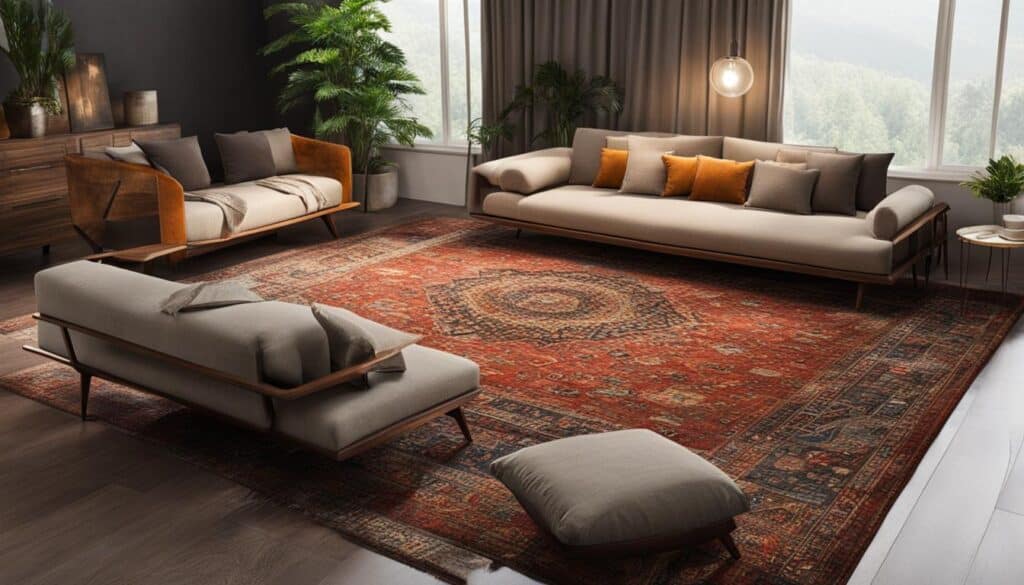When it comes to placing rugs in your living room, proper placement is key to creating a harmonious and visually pleasing space. Whether you’re considering rug placement, size, or furniture arrangement, following some important guidelines can help you achieve the desired look. Here are some expert tips to help you put rugs in your living room:
- Ensure the rug extends under all key furniture pieces in the living room.
- In a living room, all furniture should be on top of the rug.
- If not possible, have the front legs of major upholstered pieces on the rug.
- All legs of smaller pieces should be on the rug.
- In high-traffic areas, cover the entire path with the rug.
- Rug layering can add texture and visual interest to your living room.
- Use rugs to define different areas within your living room.
- Regularly vacuum your rugs and rotate them to prevent uneven wear.
- Clean spills immediately by blotting and follow the manufacturer’s cleaning instructions.
- Consider the current rug trends and color scheme of your living room.
Rug Positioning Techniques
When it comes to decorating with rugs in the living room, there are various techniques that can be used to create a stylish and visually appealing space. One popular technique is to use rugs to define different areas within a larger room. By placing a rug under a seating arrangement, you can create a cozy conversation area that feels separate from the rest of the room. This technique works particularly well in open-concept living spaces.
Rug layering is another technique that can add texture and visual interest to your living room. This involves placing multiple rugs on top of each other to create a layered look. You can layer a smaller rug over a larger one for a contrasting effect, or you can experiment with rugs of different shapes and sizes. This can be a fun way to incorporate different patterns and colors into your living room decor.
Additionally, rugs can be used to tie together different elements in the room. One way to achieve this is by matching the color of the rug to the color scheme of your furniture and decor. For example, if you have a neutral-colored sofa and accent chairs, you could choose a rug with similar tones to create a cohesive and harmonious look. This technique can help pull the entire room together and create a sense of unity.
| Rug Positioning Techniques | Description |
|---|---|
| Defining Areas | Use rugs to define different areas within a larger room, such as a seating arrangement or a reading nook. |
| Rug Layering | Create a layered look by placing multiple rugs on top of each other, either by size or shape. |
| Tying Elements Together | Match the color of the rug to the color scheme of your furniture and decor to create a cohesive look. |
Rug Care Tips for Living Room
Proper care is essential to keep your rugs in good condition and prolong their lifespan. Follow these rug care tips to ensure your living room rugs stay clean and well-maintained:
- Vacuum regularly: Regular vacuuming is crucial to remove dirt, dust, and debris that can accumulate in the rug fibers. Use a vacuum cleaner with a brush attachment or a dedicated rug cleaner for effective cleaning.
- Rotate periodically: To prevent uneven wear, rotate your rugs every few months. This helps distribute foot traffic and sunlight exposure evenly across the rug surface.
- Address spills promptly: If a spill occurs, it’s important to act quickly. Blot the spill with a clean, absorbent cloth or paper towel to absorb as much liquid as possible. Avoid rubbing the spot, as it can cause the stain to spread or become embedded in the fibers.
“Regular vacuuming is crucial to remove dirt and debris that can become embedded in the fibers.”
If a stain persists after blotting, consult the manufacturer’s cleaning instructions for specific guidance. Some rugs may require spot cleaning with mild detergent and water, while others may need professional cleaning. Avoid using harsh chemicals or excessive moisture, as it can damage the rug.
Table of Contents
Additional Rug Care Tips:
- Avoid direct sunlight: Prolonged exposure to sunlight can cause fading and discoloration. Use window treatments or UV protection film to shield your rugs from harmful UV rays.
- Use rug pads: Placing a rug pad underneath your rugs provides cushioning, prevents slipping, and helps protect the rug and the floor beneath it.
- Professional cleaning: Consider having your rugs professionally cleaned every 1-2 years, depending on the level of foot traffic and the manufacturer’s recommendations. Professional cleaning can help remove deep-seated dirt and rejuvenate the rug’s appearance.
Following these rug care tips will help maintain the beauty and longevity of your living room rugs, ensuring they continue to enhance the aesthetic appeal of your space.
| Rug Care Tips for Living Room | |
|---|---|
| Vacuum regularly | Rotate periodically |
| Address spills promptly | Use rug pads |
| Avoid direct sunlight | Professional cleaning |
Conclusion
Placing rugs in your living room is an essential aspect of decor that can instantly elevate the look and feel of the space. By following proper rug placement techniques and considering the size, shape, and color scheme of the rug, you can create a cohesive and visually pleasing living room design.
Keeping up with rug trends for the living room is important to ensure that your space stays stylish and up-to-date. Whether it’s a bold geometric pattern, a vintage-inspired design, or a natural fiber rug, staying in tune with the latest trends can help you make a statement in your living room.
Another important consideration is the rug color scheme. The color of the rug should complement the overall color scheme of the room, creating a harmonious and balanced look. From neutral tones to vibrant hues, there are endless possibilities to choose from. Don’t be afraid to experiment with different color combinations to find the perfect rug for your living room.
Lastly, proper care and maintenance of your rugs are crucial to ensure their longevity. Regular vacuuming, rotating the rug, and immediate cleaning of spills are essential practices. Following the cleaning instructions provided by the manufacturer will help you preserve the beauty and quality of your rugs for years to come.
FAQ
How should I place rugs in my living room?
According to experts, it’s best to have the rug extend under all the key pieces of furniture in the room. In a living room, all of the furniture should be on top of the rug. If this isn’t possible, it’s acceptable to have the front legs of major upholstered pieces on the rug and the back legs off, though all the legs of smaller pieces should be on the rug.
How should I position rugs to define different areas within a larger space?
One popular technique is to use rugs to create cozy conversation areas. Placing a rug under a seating arrangement can define a specific area within a larger space.
How can I use rug layering to add texture and visual interest to my living room?
Rug layering involves placing multiple rugs on top of each other. You can layer a smaller rug over a larger one or use rugs of different shapes and sizes.
How can rugs tie together different elements in my living room?
Rugs can be used to match the color scheme of the furniture and decor in your living room, creating a cohesive and balanced look.
How should I care for my rugs in the living room?
Regular vacuuming is important to remove dirt and debris. Rotate your rugs periodically to prevent uneven wear. Clean spills immediately by blotting, not rubbing. For persistent stains, professional cleaning may be necessary. Follow the manufacturer’s cleaning instructions for each specific rug.


